Chapter 25.95
OFF-STREET PARKING
Sections:
25.95.050 Development standards.
25.95.060 Preferential parking and high-occupancy vehicles.
25.95.080 Cooperative provisions.
25.95.090 Third-party consents.
25.95.010 Purpose.
The purpose of this chapter is to:
(1) Assure that the supply of off-street parking spaces reasonably satisfies demand at all but the peak demand times of year;
(2) Avoid over-reliance on on-street parking; and
(3) Retain enough scarcity so drivers have an incentive to utilize modes of transportation other than single-occupancy vehicles, and so permeable soils are not unnecessarily paved over. (Ord. 02-707 § 1)
25.95.020 Applicability.
Off-street parking shall be provided in accordance with this chapter whenever and to the extent that any building is built, enlarged, moved onto a lot, or occupied by a new use requiring more off-street parking. (Ord. 02-707 § 1)
25.95.030 Number of spaces.
(1) The minimum required and maximum allowed number of parking spaces shall be as follows, computed to the nearest whole number:
|
Land Use |
Minimum # |
Maximum # |
Per |
|
Housing reserved for senior citizens |
0.5 |
N/A |
Dwelling unit |
|
Group home |
0.25 |
N/A |
Maximum occupancy |
|
Transient guest facility |
0.5 |
N/A |
Transient unit |
|
Single-family and multifamily housing |
2 |
N/A |
Dwelling unit |
|
Office, clinic, and bank |
2 |
4 |
1,000 square feet |
|
Eating and drinking establishment |
8 |
16 |
1,000 square feet open to the public |
|
Low-intensity sales and service |
1 |
3 |
1,000 square feet |
|
High-intensity sales and service |
2 |
5 |
1,000 square feet |
|
Places of public assembly |
0.15 |
0.4 |
Person at maximum occupancy |
|
Hospital and residential health care facilities |
0.2 |
0.4 |
Bed |
|
Day care and preschools |
2 |
4 |
Working at maximum shift |
|
Industries, research facilities, print shops, bakeries, wholesales, and warehouses |
0.3 |
1 |
Working at maximum shift |
|
Commercial parking |
Not applicable (N/A) |
||
(2) The administrator shall determine parking requirements for uses not listed above, such as open-air activities, schools, plant nurseries, public utilities, outdoor recreation, mini-storage, and drive thru facilities (car wash, service stations, etc.) on a case-by-case basis.
(3) For employers implementing commute trip reduction programs, whether over or under 100 employees, the administrator may reduce the required minimum number of parking spaces to reflect the reduction in parking needs caused by the commute trip reduction program. (Ord. 02-707 § 1)
25.95.040 Location.
(1) Required off-street parking spaces shall be located in an appropriately zoned area within 500 feet walking distance from an entrance to the building served.
(2) Parking spaces shall not be located within any required vision clearance triangle.
(3) In residential areas, parking spaces shall not be located in required front yards.
(4) In commercial areas, parking spaces shall not be located in required front yards or in required side yards abutting residential areas.
(5) In manufacturing/research park areas, parking shall not be located in required front yards or within five feet of any property line.
(6) In industrial areas, parking spaces shall not be located within 20 feet of the front property line. (Ord. 02-707 § 1)
25.95.050 Development standards.
Off-street parking facilities shall:
(1) Access a public thoroughfare(s) by means of a driveway(s) that is at least 10 feet wide per lane and located with respect to intersections and crosswalks so as not to endanger or impede traffic;
(2) Incorporate maneuvering room so as not to require backing out onto a public street, except that parking spaces serving single-family residences and duplexes may utilize a street to back out provided the street is not an arterial and the driveway is at least 50 feet from the nearest street intersection;
(3) Be surfaced with a dust-free, durable material;
(4) Be designed to avoid on-site and off-site drainage problems;
(5) Incorporate adequate traffic control devices to inform users of the designed use of spaces, ingress, egress, and maneuvering spaces. Parking spaces other than those for single-family residences shall be separately identified by striping, wheel-stops, or similar means;
(6) Provide for convenient pedestrian movement from parking spaces to building entrances, sufficiently separated from vehicular traffic to ensure safety; and
(7) Conform to the landscaping provisions of this title; and
(8) All off-street parking lots shall be designed in accordance with city standards for stalls and aisles as set forth in the following table and figures:
|
A |
= |
Parking Angle |
|
B |
= |
Basic Stall Width |
|
C |
= |
Stall Depth (no bumper overhang) |
|
D |
= |
Aisle Width |
|
E |
= |
Stall Width (parallel to aisle) |
|
F |
= |
Module Width (no bumper overhang) |
|
G |
= |
Bumper Overhang |
|
H |
= |
Backing Area |
|
I |
= |
Module Intermesh |
NOTE:
1) For one row of stalls use “C” plus “D” as minimum bay width.
2) Public alley width may be included as part of dimension “D,” but all parking stalls must be on private property, off the public right-of-way.
3) For estimating available parking area, use 350 square feet per vehicle for stall, aisle and access areas.
4) The minimum aisle width for two-way traffic and for emergency vehicle operations area is 26 feet. The minimum aisle width for emergency vehicle access (one-way traffic) is 20 feet.
5) Where appropriate, bumper overhang area is provided (extruded curbs), “G” can be subtracted from “C” to determine stall depth.
6) “G” is the overhang from the wheel side of a wheel stop to the clear point of the front overhang of the vehicle.
7) Off-street parallel parking spaces shall be a minimum of eight feet wide and 23 feet long. Aisle dimensions for parallel parking are to be a minimum of 12 feet for one-way aisles and 24 feet for two-way aisles.
8) In the manufacturing/research park and industrial districts the minimum stall width shall be 9.0 feet. In all other districts the minimum stall width shall be 10.0 feet.
|
DIAGRAM IDENTIFICATION: OFF-STREET PARKING MINIMUM DIMENSIONS IN FEET |
||||||||
|
A |
B |
C |
D |
E |
F |
G |
H |
I |
|
Designed Parking Angle |
Basic Stall Width |
Stall Depth (No overhang) |
Aisle Width |
Stall Width (Parallel to aisle) |
Module Width (No overhang) |
Bumper Overhang |
Backing Area |
Module Intermesh |
|
90 Degrees Two-Way Aisle |
8.75 |
18.0 |
26.0 |
9.0 |
62.0 |
2.0 |
5.0 |
61.0 |
|
60 Degrees Two-Way Aisle |
8.75 |
18.5 |
26.0 |
10.0 |
63.0 |
2.0 |
NA |
60.0 |
|
75 Degrees One-Way Aisle |
8.75 |
19.0 |
22.0 |
9.0 |
60.0 |
2.0 |
NA |
58.0 |
|
60 Degrees One-Way Aisle |
8.75 |
18.5 |
18.0 |
10.0 |
55.0 |
2.0 |
NA |
52.0 |
|
45 Degrees One-Way Aisle |
8.75 |
17.0 |
15.0 |
12.3 |
49.0 |
2.0 |
NA |
45.0 |
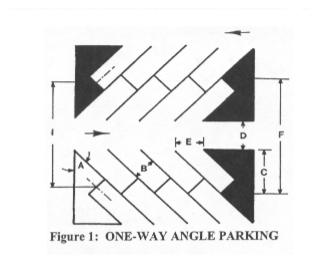
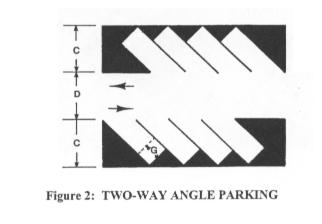
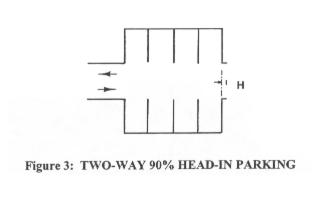
(a) Sidewalk Used as Wheel Stop. When any parking space uses a raised sidewalk for the wheel stop a minimum additional sidewalk width of three feet is required.
(b) Stall markings:
(i) Four-inch minimum width for stall markings.
(ii) Six-inch maximum width for stall markings.
(iii) Standard stall marking color: White. (Ord. 07-854 § 1; Ord. 03-752 § 1; Ord. 02-707 § 1)
25.95.060 Preferential parking and high-occupancy vehicles.
(1) Disabled parking shall be provided as required by state law.
(2) For land uses for which this chapter requires a minimum number of parking spaces per employee, at least one of every 20 employee parking spaces, rounded to the nearest whole number, shall be reserved for high-occupancy vehicles.
(3) Disabled parking, high-occupancy vehicles, and bicycles shall be given locational priority in parking space layout. (Ord. 02-707 § 1)
25.95.070 Loading.
Whenever a building is erected, enlarged, or its use changed, and the building’s use requires deliveries which could significantly endanger or impede traffic, adequate off-street loading facilities and maneuvering space for delivery vehicles shall be provided to prevent such danger or impedance.
(1) Loading Facilities Location. Off-street loading facilities shall be in all cases on the same lot or parcel of land as the structure they are intended to serve. In no case shall the off-street loading space be part of the area used to satisfy the off-street parking requirements.
No space for loading or unloading vehicles shall be so located that a vehicle using such loading space projects into any public street. Loading spaces shall be provided with access to an alley or street. Any required front, side, or rear yard may be used for loading an off-street loading space unless otherwise prohibited by this code.
(2) Loading Berth Design.
(a) All off-street loading spaces shall have a minimum unobstructed vertical clearance of not less than 15 feet.
(b) Required off-street loading spaces shall be provided in berths which conform to the following minimum specifications:
|
L |
= |
Minimum Loading Berth Length = 55 feet |
|
See DMC 25.95.070(2)(c) for modified loading berth length |
||
|
Δ |
= |
Dock Angle |
|
W |
= |
Berth Width |
|
A |
= |
Apron Width |
|
D |
= |
Clearance |
|
T |
= |
Total Offset |
(c) A Type 1 administrative approval may be granted for a single reduced size loading space based on principal building use. If granted, such space shall be no smaller than 10-foot by 40-foot.
|
DIAGRAM IDENTIFICATION: OFF-STREET |
||||
|
DOCK ANGLE (Δ) |
BERTH WIDTH (W) |
CLEARANCE (D) |
APRON (A) |
TOTAL OFFSET (T) |
|
90° |
12' |
55' |
75' |
130' |
|
60° |
12' |
48' |
55' |
103' |
|
45° |
12' |
39' |
45' |
84' |
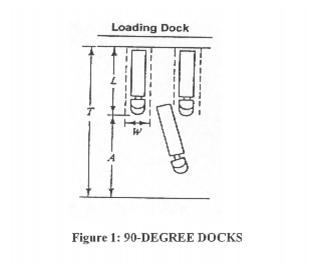
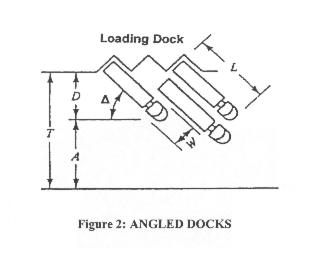
(3) It shall be unlawful to store or accumulate goods in a loading space if it renders the loading space useless for loading and unloading operations. (Ord. 03-752 § 1; Ord. 02-707 § 1)
25.95.080 Cooperative provisions.
Parking and loading facilities may be provided cooperatively. If the land uses subject to a cooperative parking provision generate their peak parking demand at different times, the administrator may reduce the total parking requirement to a number representative of the greatest demand likely to occur at any one time. (Ord. 02-707 § 1)
25.95.090 Third-party consents.
If the parking or loading facility is to be on land not owned or leased by the applicant, proof shall be supplied of the owner’s consent. (Ord. 02-707 § 1)
25.95.100 Enforcement.
Compliance with this parking chapter shall be verified before issuance of any land use or building permit. (Ord. 02-707 § 1)


